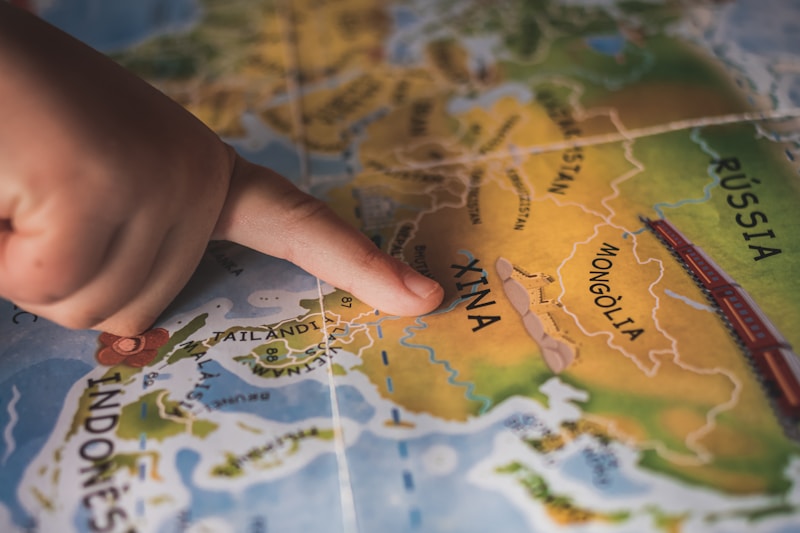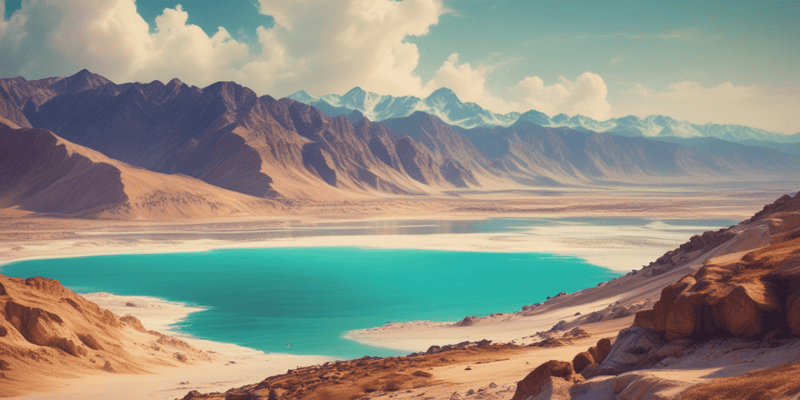Podcast
Questions and Answers
What will happen when the orbit of a heavenly body is nearest to the Sun?
What will happen when the orbit of a heavenly body is nearest to the Sun?
At the road construction site, John saw a layer of land with the finest soil particles and more humus. Identify the layer observed by him.
At the road construction site, John saw a layer of land with the finest soil particles and more humus. Identify the layer observed by him.
Keino wants to transport his car from Japan to Tanzania. Which mode of transport would be best to use?
Keino wants to transport his car from Japan to Tanzania. Which mode of transport would be best to use?
Songoro prefers to cultivate vegetables, maize, and beans on his farm. What type of farming is he practicing?
Songoro prefers to cultivate vegetables, maize, and beans on his farm. What type of farming is he practicing?
Signup and view all the answers
Sometimes people living in the central part of Tanzania experience sudden vibrations of the Earth's surface caused by movement of the molten rocks below or within the crust. Identify the instrument to be used to measure the magnitude of such vibrations.
Sometimes people living in the central part of Tanzania experience sudden vibrations of the Earth's surface caused by movement of the molten rocks below or within the crust. Identify the instrument to be used to measure the magnitude of such vibrations.
Signup and view all the answers
Coastal areas do not maintain their shape due to erosional and depositional processes. Which factors influence those processes?
Coastal areas do not maintain their shape due to erosional and depositional processes. Which factors influence those processes?
Signup and view all the answers
It is noon in Addis Ababa (39°E). What will be the time in Dar es Salaam which is located along the same longitude?
It is noon in Addis Ababa (39°E). What will be the time in Dar es Salaam which is located along the same longitude?
Signup and view all the answers
Which factors cause Tanzania's population structure to be dynamic?
Which factors cause Tanzania's population structure to be dynamic?
Signup and view all the answers
What could be the appropriate method for extracting gold deposits which are near to the surface?
What could be the appropriate method for extracting gold deposits which are near to the surface?
Signup and view all the answers
Why are Japanese shipbuilding industries located along the coast?
Why are Japanese shipbuilding industries located along the coast?
Signup and view all the answers
Match the description of environmental issues in List A with their environmental concepts in List B:
Match the description of environmental issues in List A with their environmental concepts in List B:
Signup and view all the answers
Study Notes
Geography CSEE Examination 2023
- The examination paper consists of three sections: A, B, and C.
- Section A has 10 multiple-choice questions worth 16 marks in total.
- Section B has 6 questions worth 54 marks in total.
- Section C has 3 questions worth 30 marks in total.
- Students must answer all questions in sections A and B and two questions from section C.
Section A
-
Question 1:
- Perihelion is the point in a celestial body's orbit where it is closest to the Sun.
- The A horizon is the top layer of soil, characterized by fine particles and humus.
- Water transport is the best option for transporting a car from Japan to Tanzania.
- Mixed farming involves cultivating crops and raising livestock.
- The Richter Scale measures the magnitude of earthquakes.
- Factors affecting coastal erosion and deposition include wind strength, weather conditions, sea depth, and rock type.
- Time in Dar es Salaam will be the same as in Addis Ababa (39°E) because they are on the same longitude.
- Population structure is dynamic due to factors such as fertility, mortality, and migration.
- Alluvial mining involves extracting minerals from unconsolidated sediments near the surface.
- Japanese shipbuilding industries are located along the coast due to the presence of natural harbors.
-
Question 2:
- Drought describes a period of prolonged dryness.
- Pollution refers to the addition of unwanted substances into the environment.
- Land degradation encompasses the deterioration of soil fertility and quality.
- Climate change refers to gradual shifts in rainfall and temperature patterns.
- Loss of biodiversity represents the decline in species populations within an area.
- Desertification is the process of fertile land turning into dry and barren landscapes.
- Deforestation involves the removal of trees from an area.
- Soil erosion is the process of fertile topsoil being carried away by wind or water.
Section B
-
Question 3 refers to the Map Extract of Liwale (Sheet 280/4).
- The dominant rock type is sedimentary, indicated by the presence of plains and valleys, suggesting deposition over time.
- Sedimentary rocks are typically layered, formed from the accumulation of sediments, and may contain fossils.
- Liwale town likely grew because of its central location in the agricultural region and the presence of cotton buying posts, indicating economic activity.
- Measuring the distance between the grid references 814218 and 809165 using the stated 1: 50,000 map scale will allow the student to determine the distance in kilometers.
-
Question 4 focuses on research methodology.
- Selecting representatives for research is referred to as sampling.
- Techniques for selecting representatives include random sampling (choosing participants randomly) and stratified sampling (grouping participants based on characteristics and selecting randomly from each group).
- Advantages of sampling include:
- Cost-effectiveness compared to studying the entire population.
- Time efficiency.
- Easier data analysis.
-
Question 5 is about survey methods.
- Traverse surveying is a suitable method for measuring straight lines between points.
- The first step involves setting up a baseline and the last includes calculating distances between points.
- Survey equipment includes:
- Measuring tape for accurate distance measurement.
- Total station for precise measurement and data recording.
- Level for determining elevation differences.
-
Question 6 analyzes a photograph.
- The photograph most likely shows a coastal landscape based on the presence of features such as cliffs, beaches, and vegetation typical of shoreline environments.
- Depositional features may include beaches and sand dunes.
- Erosional features may include cliffs and wave-cut platforms.
- Man-made features could include roads, buildings, or harbors.
- Formation of the main marine erosion feature likely involves:
- Initial sea level at the base of the cliff,
- Wave erosion continuously carving out the cliff base,
- Retreating cliff as the erosional process continues.
-
Question 7 focuses on glacial features.
-
Students observing a Swiss landscape would likely see features like:
- U-shaped valleys sculpted by glaciers.
- Cirques (bowl-shaped depressions at the head of glaciers).
- Aretes (sharp ridges formed by glaciers eroding opposing sides of a mountain).
- Hanging valleys (valleys carved by smaller glaciers, hanging high above the main glacial valley).
-
A well-labeled diagram showing these features is required for the answer.
-
Question 8
- Plants in deserts adapt through:
- Deep roots to reach groundwater.
- Waxy leaves to reduce water loss.
- Succulent stems to store water.
- Thorns to deter herbivores
- Reduced leaf size to minimize surface area for water evaporation.
- Characteristics of desert vegetation include:
- Drought-resistant.
- Sparse distribution.
- Specialized adaptations.
- Small, tough leaves.
- Plants in deserts adapt through:
Section C
-
Question 9 examines temperature change during a journey.
- Possible causes of increasing temperature include:
- Altitude: Temperature generally decreases with increasing altitude.
- Latitude: Temperature generally increases closer to the equator.
- Distance from the coast: Coastal areas have a moderating effect on temperature due to water's heat capacity.
- Cloud cover: Clouds tend to reflect sunlight and lower temperatures.
- Air currents: Warm air currents can raise temperatures.
- Seasonal changes: Some areas experience greater temperature variation depending on the time of year.
- Possible causes of increasing temperature include:
-
Question 10 addresses environmental degradation.
- Measures to prevent environmental degradation include:
- Sustainable agriculture to minimize soil erosion and pollution.
- Reforestation to restore degraded ecosystems.
- Waste management to reduce pollution and resource depletion.
- Renewable energy to reduce dependence on fossil fuels.
- Pollution control to reduce emissions and improve air and water quality.
- Conservation efforts to protect biodiversity and ecosystems.
- Measures to prevent environmental degradation include:
-
Question 11 focuses on renewable energy sources in Tanzania.
- Renewable energy sources in Tanzania include:
- Solar energy: Abundant sunshine provides a significant resource for solar power.
- Wind energy: Coastal and mountainous regions offer favorable conditions for wind power.
- Geothermal energy: Volcanic activity in some areas provides potential for geothermal energy.
- Hydropower: Numerous rivers and waterfalls provide hydroelectric potential.
- Biomass energy: Abundant agricultural waste and wood can be used for energy production.
- Biogas: Organic waste can be converted into biogas for cooking and other purposes.
- Renewable energy sources in Tanzania include:
Studying That Suits You
Use AI to generate personalized quizzes and flashcards to suit your learning preferences.
Related Documents
Description
Test your knowledge with the Geography CSEE Examination 2023. This quiz covers various topics from celestial mechanics to soil layers and coastal processes. Emphasize your understanding of geography and spatial relationships relevant to this year's curriculum.




